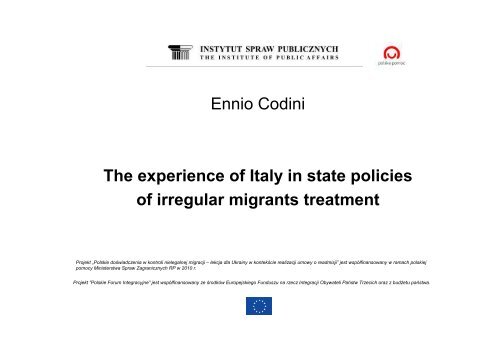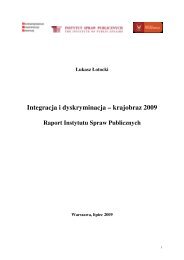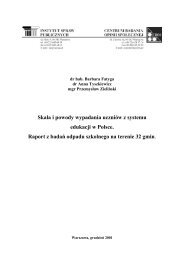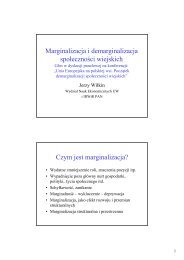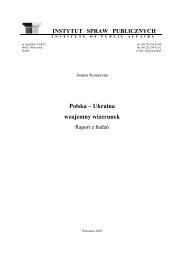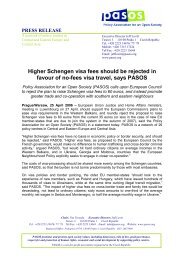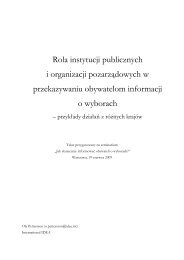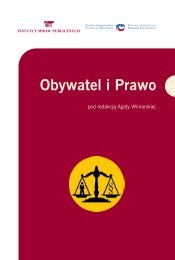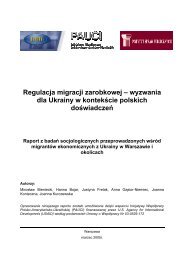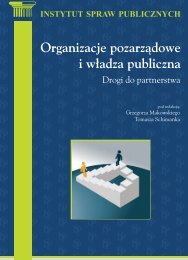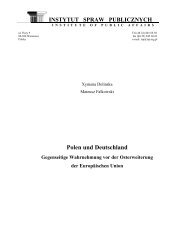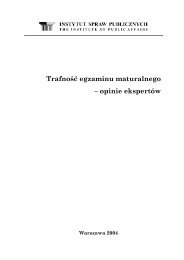Ennio Codini The experience of Italy in state policies of irregular ...
Ennio Codini The experience of Italy in state policies of irregular ...
Ennio Codini The experience of Italy in state policies of irregular ...
You also want an ePaper? Increase the reach of your titles
YUMPU automatically turns print PDFs into web optimized ePapers that Google loves.
<strong>Ennio</strong> <strong>Cod<strong>in</strong>i</strong><strong>The</strong> <strong>experience</strong> <strong>of</strong> <strong>Italy</strong> <strong>in</strong> <strong>state</strong> <strong>policies</strong><strong>of</strong> <strong>irregular</strong> migrants treatmentProjekt „Polskie doświadczenia w kontroli nielegalnej migracji – lekcja dla Ukra<strong>in</strong>y w kontekście realizacji umowy o readmisji” jest współf<strong>in</strong>ansowany w ramach polskiejpomocy M<strong>in</strong>isterstwa Spraw Zagranicznych RP w 2010 r.Projekt ”Polskie Forum Integracyjne” jest współf<strong>in</strong>ansowany ze środków Europejskiego Funduszu na rzecz Integracji Obywateli Państw Trzecich oraz z budŜetu państwa.
IntroductionToday I just want to answer to three questionsFirstly: What are the ma<strong>in</strong> characteristics <strong>of</strong> illegalimmigration <strong>in</strong> <strong>Italy</strong>?Secondly: How does <strong>Italy</strong> try to manage the illegalimmigration?And f<strong>in</strong>ally: What are the ma<strong>in</strong> ideas about the future<strong>of</strong> illegal immigration?
<strong>The</strong> scale <strong>of</strong> <strong>irregular</strong> migration to<strong>Italy</strong>In the late twenty yearsevery yearmore than 100,000foreign workers entered <strong>in</strong> <strong>Italy</strong>as illegal immigrants(we are go<strong>in</strong>g to use “<strong>irregular</strong> migrants”, “illegal immigrants” or similarwords. No human be<strong>in</strong>g is <strong>irregular</strong> or illegal, <strong>of</strong> course, but this is thecommon term<strong>in</strong>ology)
<strong>The</strong> types <strong>of</strong> illegal migratory run<strong>The</strong>re are two different k<strong>in</strong>ds <strong>of</strong> <strong>experience</strong>[<strong>Cod<strong>in</strong>i</strong>, 2005]:Illegal entries - clandest<strong>in</strong>e migrantsLegal entries with an <strong>in</strong>appropriate andnon-convertible title. <strong>The</strong>upshot is the illegal stay (overstayers)
<strong>The</strong> stabilisation <strong>of</strong> <strong>irregular</strong> immigrantsAccord<strong>in</strong>g to the law the illegal immigrantsshould be expelled but less than 10,000expulsions are realized every year (<strong>The</strong>re areplenty <strong>of</strong> organizational problems)So every year at least 100,000 new illegalimmigrants can take up residence <strong>in</strong> thecountry
A tolerant approachHow did the Italian society reacts to this situation?How did the Italian authorities react to this situation?<strong>The</strong>re was a certa<strong>in</strong> amount <strong>of</strong> tolerance. Why? Because theillegal immigrants are an unique opportunity for the shadoweconomy.<strong>The</strong>re are three ma<strong>in</strong> sectors: domestic work, build<strong>in</strong>g <strong>in</strong>dustryand agriculture. <strong>The</strong> 50% <strong>of</strong> illegal immigrants are womenwork<strong>in</strong>g as home helps or home caregivers [Cesareo, 2007;Zanfr<strong>in</strong>i, 2008]
<strong>The</strong> limit on toleranceWhen the illegal immigrants become more than500,000 the tolerance decreases sharply and a newattitude comes along: alarmWhy? First, because <strong>of</strong> the fear that crimes might rise.Second, it is difficult to accept such a big under classIn addition, this mass <strong>of</strong> illegal immigrants candramatically <strong>in</strong>crease the shadow economy
<strong>The</strong> extraord<strong>in</strong>ary measures<strong>The</strong> upshot are extraord<strong>in</strong>ary measuresGoals:- first, to grant a residence permit to almost all present <strong>irregular</strong>migrants- second, to promote the emergence <strong>of</strong> <strong>irregular</strong> labour<strong>The</strong>re have been two types <strong>of</strong> extraord<strong>in</strong>ary measures:mass regularisations and decrees on migration flows
<strong>The</strong> Mass Regularizations*1990-1992 – Prime M<strong>in</strong>. Andreotti – 220,000 permits*1995-1997 – Prime M<strong>in</strong>. D<strong>in</strong>i – 250,000 permits*1998-2000 – Prime M<strong>in</strong>. Prodi – 220,000 permits*2002-2004 – Prime M<strong>in</strong>. Berlusconi– 650,000 permits*2009-2010 (only for domestic workers and care givers) –Prime M<strong>in</strong>ister Berlusconi – 280,000 permits<strong>The</strong> grant <strong>of</strong> a residence permit is usually subord<strong>in</strong>ated to thesignature <strong>of</strong> a job contract - except the case <strong>of</strong>1990 and 1998 amnesties
<strong>The</strong> decrees on migration flows asregularisation measure2006-2007 – <strong>The</strong> Prodi Government faced theproblem <strong>of</strong> the massive presence <strong>of</strong><strong>irregular</strong> immigrants us<strong>in</strong>g the decrees onmigration flows: 500,000 permits(In the same time there is the transition <strong>of</strong>Romanians from the status <strong>of</strong> third-countrynationals to that <strong>of</strong> EU citizens soRomanians are no longer counted as illegalmigrants)
ConsequencesEvery year at least 100,000 new illegal immigrants cantake up residence <strong>in</strong> the country.<strong>The</strong>refore extraord<strong>in</strong>ary measures aim<strong>in</strong>g toma<strong>in</strong>ta<strong>in</strong> the illegal immigrants under thetolerance limit are adopted<strong>The</strong> result is the trend <strong>of</strong> the number <strong>of</strong> <strong>irregular</strong> migrants<strong>in</strong>dicated by the follow<strong>in</strong>g slide
Estimated number <strong>of</strong> <strong>irregular</strong> migrants liv<strong>in</strong>g <strong>in</strong> <strong>Italy</strong>. Years1990-2009 (thousands)Source: Fondazione ISMU
A necessary use<strong>The</strong> use <strong>of</strong> extraord<strong>in</strong>ary measures<strong>of</strong> regularisation was necessary<strong>The</strong> number <strong>of</strong> regularised who fell aga<strong>in</strong><strong>in</strong>to an illegal status has been rather limited.In 2005, for example, over 98% <strong>of</strong> foreignerswho could benefit <strong>in</strong> 2002-2004from regularisation measures were ableto keep they regular status [Cesareo, 2007]
Critical aspects <strong>of</strong> the use<strong>of</strong> extraord<strong>in</strong>ary measuresMass regularisations can impair the image <strong>of</strong> theItalian law system, mak<strong>in</strong>g it appear scarcely rigorousand, at the same time, they can produce a “call” effect[Cesareo, 2007; Zanfr<strong>in</strong>i, 2008]<strong>The</strong> improper use <strong>of</strong> the decrees on migration flowsdenies the possibility to use them correctly, andconsequently the possibility to legally enter for workpurposes [<strong>Cod<strong>in</strong>i</strong>, 2010]
Widespread op<strong>in</strong>ions about the futureAn op<strong>in</strong>ion: the phenomenon <strong>of</strong> massimmigration should run out <strong>in</strong> the future due tothe economic crisis and the availability <strong>of</strong> EUworkersAnother op<strong>in</strong>ion: new sanctions will still be ableto block illegal immigration
How to judge these op<strong>in</strong>ions<strong>The</strong> build<strong>in</strong>g <strong>in</strong>dustry is <strong>in</strong> severe crisisToday <strong>in</strong> <strong>Italy</strong> there are at least a million RomaniansBut <strong>in</strong> Romania the surplus <strong>of</strong> entries <strong>in</strong> the labourmarket is dest<strong>in</strong>ed to change <strong>in</strong>to lack <strong>of</strong> workforcethe migration flow will end up [Blangiardo, 2009]Regard<strong>in</strong>g the crisis <strong>in</strong> the build<strong>in</strong>g <strong>in</strong>dustry:the domestic work is more important than build<strong>in</strong>g<strong>The</strong> Italian demographic crisis cont<strong>in</strong>ues<strong>The</strong> mass immigration will cont<strong>in</strong>ue
Cont<strong>in</strong>uesDo penalties enable to effectively manage<strong>irregular</strong> migration? No, they don’tIn general sanctions and penalties have notproved suitable to br<strong>in</strong>g back illegality with<strong>in</strong>acceptable levels
A reasonable strategyTo reduce the shadow economy [Zanfr<strong>in</strong>i, 2008]To change the rules on the entry <strong>of</strong> workersTo provide an ord<strong>in</strong>ary regularisation mechanism[Cesareo, 2007] follow<strong>in</strong>g the model that we f<strong>in</strong>d<strong>in</strong> the French and <strong>in</strong> the Spanish law system
Will this strategy be adopted?Will this strategy be adopted?Not at present<strong>Italy</strong> will cont<strong>in</strong>ues to wrestle with the challengesposed by a mass illegal migrationIn the com<strong>in</strong>g years will cont<strong>in</strong>ue to make massiveuse <strong>of</strong> extraord<strong>in</strong>ary measures <strong>of</strong> massregularisation
Bibliography• BLANGIARDO G. C. (2009) An Updated Picture and Prospects Concern<strong>in</strong>gthe Quantitative Aspects <strong>of</strong> Foreigners’ Presence <strong>in</strong> <strong>Italy</strong> – ISMU, <strong>The</strong>Fourteenth…39-64.• BLANGIARDO G. C. (2010) Foreigners’ Presence <strong>in</strong> <strong>Italy</strong>: From aReference Framework to Future Development Scenarios – ISMU, <strong>The</strong>Fifteenth… 33-56.• CESAREO V. (2007), Immigrants Regularisation Processes <strong>in</strong> <strong>Italy</strong>,Polimetrica, Monza, 2007• CODINI E. (2010) Developments <strong>in</strong> Law and Regulations – ISMU, <strong>The</strong>Fifteenth… 57-72• ISMU, <strong>The</strong> Fourteenth Italian Report on Migrations 2008, Monza 2009• ISMU, <strong>The</strong> Fifteenth Italian Report on Migrations 2009, Monza 2010• ZANFRINI L. (2008), Italian policy on <strong>irregular</strong> migrants <strong>in</strong> the labour marketand the shadow economy, L.ZANFRINI and W.KLUTH, Policies… 29-70• ZANFRINI L.and KLUTH W. (2008), Policies on <strong>irregular</strong> migrants, Council<strong>of</strong> Europe, Strasbourg, 2008


